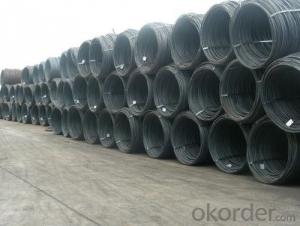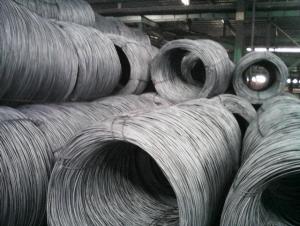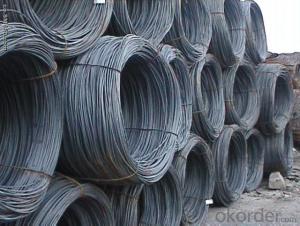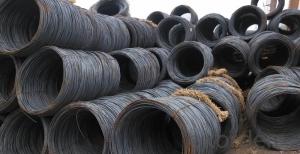Hot Rolled Carbon Steel Wire Rod
- Loading Port:
- Tianjin
- Payment Terms:
- TT OR LC
- Min Order Qty:
- -
- Supply Capability:
- 200000 m.t./month
OKorder Service Pledge
OKorder Financial Service
You Might Also Like
Specifications of Hot Rolled Carbon Steel Wire Rod:
Steel Grade: Q195/235, SAE1006-1018B Standard: ASTM, GB
Diameter: 5.5mm, 6.5mm, 7mm,8mm,9mm,10mm,12mm,14mm
Diameter tolerance: ±0.3mm Type: in coil, coil weight around 2MT
Technique: Hot Rolled Place of Origin: China Mainland
Surface: round, no twisted, light and smooth Brand Name: HSKY
Chemical Composition: (Please kindly find our chemistry of our material based on Q195、Q235A and Q235B as below for your information)
Trademark | Rank | Chemical composition (quality score) % | |||||
C | Si | Mn | S | P | |||
| ≤ |
| ≤ | ≤ | |||
Q195 |
| 0.06-0.12 | 0.30 | 0.25 | 0.050 | 0.045 | |
Q235 | A | 0.14-0.22 | 0.30 | 0.30-0.65 | 0.050 | 0.045 | |
Q235 | B | 0.12-0.20 | 0.30 | 0.30-0.70 | 0.045 | 0.045 | |
Trademark | Rank | Pulling Test | |||||
Bend PointΔs/Mpa | Tensile Strength | Elongation Ratioδ5% | |||||
Thickness (Diameter) /MM | Thickness (Diameter) /MM | ||||||
≤16 | 16-40 | ≤16 | 16-40 | ||||
≥ | ≥ | ||||||
Q195 |
| 195 | 185 | 315-390 | 33 | 32 | |
Q235 | A | 235 | 225 | 375-500 | 26 | 25 | |
Q235 | B | 235 | 225 | 375-500 | 26 | 25 | |
Usage and Applications of Hot Rolled Carbon Steel Wire Rod:
After hot-rolled the products shaped into coil and delivery as finished product, including round, square, rectangular, hexagonal and so on. Since most of the products are round, it is generally called wire rod. Carbon steel wire rod is widely used in construction and manufacturing. Carbon steel wire rod is mainly used for reinforcement of reinforced concrete and welded structure or reprocessed (roberts , nail, etc.) materials, especially used to produce wire drawing, welding electrode, nails, spring, electronic, precise machinery parts and so on.
Packaging & Delivery of Hot Rolled Carbon Steel Wire Rod:
Packaging Detail: products are packed in coil, each coil weight around 2 MT, and then shipped by container or bulk vessel
Delivery Detail: within 45 days after received deposit or LC.
Label: to be specified by customer, generally, each bundle has 1-2 labels
Trade terms: FOB, CFR, CIF
Carbon Steel Wire Rod on Port

Carbon Steel Wire Rod in Container
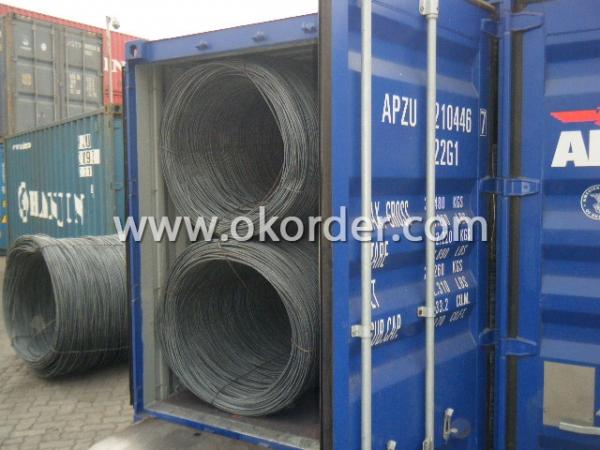
Note:
1. Our products are produced according to national standard (GB), if not, supply according to national standards (GB) or agreement as customer required.
2. Other Grade and Standard carbon steel wire rod we can supply:
Grade:H08A, 30MnSi, 62B-82B
Standard: AISI, BS, JIS, DIN
The Minimum Order Quantity of these products is high, and need to be confirmed.
3. We can not only supply carbon steel wire rod; if you need anything about building materials, please contact us.
4. Please send us your detail specifications when inquire. We will reply to you as soon as possible.We sincerely hope we can establish a long stable business relationship.
- Q: What are the different types of steel wire rod cooling methods?
- The industry commonly uses various steel wire rod cooling methods, aiming to efficiently cool down the wire rod after hot rolling mill processing. Depending on the desired properties and specifications of the wire rod, cooling methods can vary. A cost-effective and energy-efficient cooling method is air cooling, where the wire rod is exposed to ambient air, allowing natural convection to dissipate heat. However, this method may not be suitable for all applications as it may not provide the desired cooling rate or uniformity. For a high cooling rate and quick solidification, water cooling is utilized. This involves spraying water onto the wire rod. It is widely used in high-speed wire rod mills where achieving desired mechanical properties requires a fast cooling rate. In specific applications where specific hardness or strength is required, oil quenching is used. Wire rods are rapidly cooled by immersing them in oil, such as mineral oil or polymer-based oil. Controlled cooling rates achieved through oil quenching result in the desired microstructure and mechanical properties. Advanced cooling methods incorporate innovative technologies such as forced air cooling and water mist cooling. Forced air cooling employs high-velocity air jets to rapidly cool the wire rod, while water mist cooling uses a fine mist of water droplets for efficient cooling. These methods offer enhanced cooling rates and can be tailored to specific requirements. In conclusion, steel wire rod cooling methods include air cooling, water cooling, oil quenching, forced air cooling, and water mist cooling. Each method has its advantages and is chosen based on the desired properties and specifications of the wire rod.
- Q: What are the common industry certifications for steel wire rod professionals?
- Some common industry certifications for steel wire rod professionals include the Certified Steel Wire Rod Specialist (CSWRS) certification, the Certified Wire Rod Technician (CWRT) certification, and the Certified Wire Rod Quality Control Professional (CWRQCP) certification. These certifications demonstrate a professional's knowledge and expertise in various aspects of steel wire rod production, quality control, and technical understanding.
- Q: How is steel wire rod used in the production of wire ropes for cranes?
- Steel wire rod is an essential component for crane wire rope production. Wire ropes used in cranes need to have high tensile strength, durability, and flexibility in order to withstand heavy loads and frequent use. These necessary characteristics are provided by steel wire rods, which are typically made from carbon steel or alloy steel. The production of wire ropes begins with the drawing process. Steel wire rods are drawn through a series of dies to reduce their diameter and increase their length. This process, known as cold drawing, not only improves the wire rod's surface finish but also enhances its tensile strength. By subjecting the wire rod to this process, it becomes thinner, longer, and stronger. After the cold drawing process, the wire rod is further processed to form individual wires. These wires are then arranged in a specific pattern, helically laid around a core, forming strands. The number and arrangement of strands depend on the desired strength and flexibility of the wire rope. The high tensile strength of the steel wire rod ensures that the resulting wires and strands can withstand the significant forces involved in crane operations. Once the strands are formed, they are carefully laid together around a central core to create the final wire rope. The durability and flexibility of the steel wire rod allow the wire rope to endure bending, twisting, and stretching without breaking or losing its shape. This is crucial for cranes, as they often work in harsh conditions and undergo repetitive cycles of heavy lifting. Additionally, the steel wire rod used in wire rope production undergoes various heat treatment processes to enhance its mechanical properties. These treatments modify the steel's microstructure, increasing its strength and toughness. Processes like annealing, quenching, and tempering ensure that the wire rope can withstand the demanding working conditions of cranes. In conclusion, steel wire rod is a critical component in the production of wire ropes for cranes. Its high tensile strength, durability, and flexibility are essential for withstanding heavy loads and frequent use. Through processes such as cold drawing and heat treatment, the steel wire rod's mechanical properties are improved, ensuring that the resulting wire rope can endure the demanding operations of cranes.
- Q: How is steel wire rod tested for fatigue strength?
- Steel wire rod is tested for fatigue strength through a process called fatigue testing. This involves subjecting the wire rod to repeated cycles of stress, simulating real-world conditions. The wire rod is loaded with a specific stress level and then subjected to a predetermined number of cycles until failure occurs. The number of cycles endured before failure is measured, providing an indication of the wire rod's fatigue strength.
- Q: How is the brittleness of steel wire rod determined?
- The brittleness of steel wire rod is typically determined by conducting a series of mechanical tests, such as the Charpy impact test or the tensile test. These tests help measure the amount of force or energy required to fracture or break the steel wire rod, providing an indication of its brittleness. Additionally, microscopic examination techniques, like optical microscopy or scanning electron microscopy, can be used to analyze the internal structure of the steel wire rod and identify any signs of brittleness, such as the presence of cracks or grain boundaries.
- Q: What are the main factors influencing the choice of steel wire rod order payment refund options?
- The main factors influencing the choice of steel wire rod order payment refund options can vary depending on various factors. However, some common factors that play a significant role in this decision-making process include: 1. Supplier Reputation: The reputation and trustworthiness of the supplier is a crucial factor. Buyers tend to choose payment refund options that provide them with a sense of security in case of any issues or disputes with the supplier. 2. Order Volume and Value: The size and value of the steel wire rod order can impact the choice of payment refund options. Larger orders with higher values may require more secure refund options to mitigate potential financial risks. 3. Payment Terms and Conditions: The payment terms and conditions set by the supplier can influence the choice of refund options. Some suppliers may offer specific refund options based on their preferred payment methods, such as bank transfers, letters of credit, or escrow services. 4. Buyer's Financial Capability: The financial capability of the buyer can also determine the choice of refund options. Buyers with limited financial resources may opt for payment refund options that offer flexibility and minimize risks, such as installment payments or delayed payment terms. 5. Delivery and Quality Assurance: The reliability and quality assurance provided by the supplier can impact the choice of refund options. Buyers may prefer refund options that allow them to inspect the steel wire rod upon delivery and ensure compliance with the agreed specifications before making full payment. 6. Market Conditions and Competition: Market conditions and competition among suppliers can influence the choice of refund options. Buyers may consider refund options that are more favorable or competitive in the market, such as cash discounts or rebates. 7. Legal and Regulatory Considerations: Legal and regulatory requirements in the buyer's jurisdiction can also affect the choice of refund options. Buyers may opt for refund options that comply with local regulations and provide legal protection in case of any disputes or non-compliance. It is important for buyers to carefully evaluate these factors and assess their specific needs and preferences before deciding on the most suitable payment refund options for their steel wire rod orders.
- Q: What are the different surface roughness measurement methods for steel wire rod?
- Steel wire rod can be assessed for its surface quality and smoothness using various methods. These methods are crucial for applications like wire drawing, machining, and coating. The commonly used methods for measuring surface roughness of steel wire rod include: 1. Contact Profilometry: This method involves physically scanning the wire rod's surface using a stylus or probe. The stylus moves across the surface and records any irregularities. The data obtained can then be used to calculate roughness parameters such as Ra and Rz. 2. Optical Profilometry: This method utilizes optical techniques to measure surface roughness. It involves projecting light onto the wire rod's surface and capturing the reflected light with a camera or other optical sensors. The captured data is then analyzed to determine roughness parameters. 3. Laser Scanning: For non-contact measurement, laser scanning is used. A laser beam is directed at the wire rod's surface, and the reflected beam is analyzed to calculate roughness parameters. This method provides highly accurate results and detailed surface topography information. 4. Atomic Force Microscopy (AFM): AFM is a high-resolution imaging technique that measures surface roughness at the nanoscale level. It involves scanning a sharp tip across the surface and detecting the interaction forces between the tip and the surface. The collected data is used to create a detailed topographic image and calculate roughness parameters. 5. Electromagnetic Eddy Current: This method employs electromagnetic fields to measure surface roughness. Eddy currents are induced in the wire rod's surface, and the changes in these currents are measured and analyzed to determine roughness parameters. This technique is particularly useful for measuring roughness on conductive materials. These surface roughness measurement methods have their own advantages and limitations. The choice of method depends on factors such as the required accuracy, speed, and specific characteristics of the steel wire rod being measured.
- Q: How is steel wire rod tested for resistance to stress corrosion cracking?
- Steel wire rod is tested for resistance to stress corrosion cracking through a series of standardized tests. One commonly used method is the slow strain rate testing (SSRT), where the rod is subjected to a controlled and slow deformation under corrosive conditions. The test measures the time it takes for cracks to initiate and propagate, providing valuable information about the material's susceptibility to stress corrosion cracking. Additionally, other techniques such as electrochemical testing and hydrogen embrittlement testing may also be employed to assess the resistance of steel wire rod to stress corrosion cracking.
- Q: What is the average lifespan of steel wire rod?
- The average lifespan of steel wire rods can vary depending on factors such as usage, maintenance, and environmental conditions. However, with proper care and regular maintenance, steel wire rods can typically last for several years to decades.
- Q: How is steel wire rod used in the production of wire for suspension bridge cables?
- Steel wire rod is a crucial raw material used in the production of wire for suspension bridge cables. It is first processed at a steel mill, where it is heated and rolled into long, continuous wire rods. These wire rods are then further processed and drawn through a series of dies to reduce their diameter while increasing their strength. By subjecting the wire rod to this drawing process, the steel becomes more flexible and able to withstand the tension and pressure experienced by suspension bridge cables. The resulting wire is then twisted or braided together to form the final cable, which is used to support and suspend the bridge structure, ensuring its stability and durability.
Send your message to us
Hot Rolled Carbon Steel Wire Rod
- Loading Port:
- Tianjin
- Payment Terms:
- TT OR LC
- Min Order Qty:
- -
- Supply Capability:
- 200000 m.t./month
OKorder Service Pledge
OKorder Financial Service
Similar products
Hot products
Hot Searches
Related keywords









